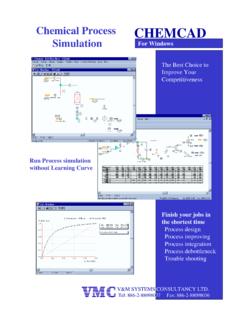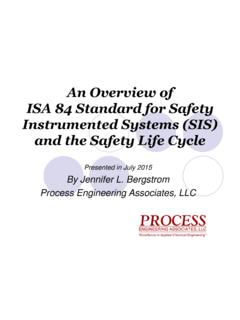Transcription of E1-MNL032A - CHEMCAD is a suite of chemical process ...
1 DESIGN AND RATING shell AND TUBE heat EXCHANGERS By John E. Edwards Design and Rating of shell and Tube heat Exchangers PAGE 2 OF 30 MNL 032A Issued 29 August 08, Prepared by of P & I Design Ltd, Teesside, UK Contents Introduction Fundamentals Basic Theory heat Transfer Model Selection Design Guidelines Appendices I Thermal Design Models Synopsis II CC-THERM User Guidelines III Thermal Model Selection IV Shortcut heat Exchanger Design V TEMA heat Exchanger Layout Designation VI Typical Overall heat Transfer Coefficients VII Typical Resistance Fouling Coefficients VIII LMTD Correction Factor Ft IX Wolverine Tube General Details X Midland Wire Cordage Turbulator Details XI Tube Dimensional Data XII shell Tube Count Data References 1.
2 Hewitt, et al (1994) process heat Transfer, (CRC Press) 2. Perry, and Green, D. (1984) Perry s chemical Engineers Handbook, 6th edition (McGraw Hill) 3. Kern, (1950) process heat Transfer (McGraw Hill) 4. Coulson, and Richardson, (1993) chemical Engineering Vol 1, 4th edition (Pergamon) 5. Skinnet, (1993) Coulson & Richardson s chemical Engineering Vol 6, 2nd edition (Pergamon) 6. Chemstations,Inc. CHEMCAD THERM Version User Guide 7. Schlunder, (1993) VDI heat Atlas (Woodhead Publishing) 8. Seider, , Seader, and Lewin, process Design Principles, (John Wiley & Sons, Inc.) [ C20] References of this type are to be found in CC-THERM > Help > Appendix Design and Rating of shell and Tube heat Exchangers PAGE 3 OF 30 MNL 032A Issued 29 August 08, Prepared by of P & I Design Ltd, Teesside, UK 1.
3 0 Introduction shell and tube heat exchangers are used extensively throughout the process industry and as such a basic understanding of their design, construction and performance is important to the practising engineer. The objective of this paper is to provide a concise review of the key issues involved in their thermal design without having to refer to the extensive literature available on this topic. The author claims no originality but hopes that the format and contents will provide a comprehensive introduction to the subject and enable the reader to achieve rapid and meaningful results. The optimum thermal design of a shell and tube heat exchanger involves the consideration of many interacting design parameters which can be summarised as follows: process 1. process fluid assignments to shell side or tube side.
4 2. Selection of stream temperature specifications. 3. Setting shell side and tube side pressure drop design limits. 4. Setting shell side and tube side velocity limits. 5. Selection of heat transfer models and fouling coefficients for shell side and tube side. Mechanical 1. Selection of heat exchanger TEMA layout and number of passes. 2. Specification of tube parameters - size, layout, pitch and material. 3. Setting upper and lower design limits on tube length. 4. Specification of shell side parameters materials, baffle cut, baffle spacing and clearances. 5. Setting upper and lower design limits on shell diameter, baffle cut and baffle spacing. There are several software design and rating packages available, including AspenBJAC, HTFS and CC-THERM, which enable the designer to study the effects of the many interacting design parameters and achieve an optimum thermal design.
5 These packages are supported by extensive component physical property databases and thermodynamic models. It must be stressed that software convergence and optimisation routines will not necessarily achieve a practical and economic design without the designer forcing parameters in an intuitive way. It is recommended that the design be checked by running the model in the rating mode. It is the intention of this paper to provide the basic information and fundamentals in a concise format to achieve this objective. The paper is structured on Chemstations CC-THERM software which enables design and rating to be carried out within a total process model using CHEMCAD steady state modelling software. However the principles involved are applicable to any software design process .
6 In the Attachments a Design Aid is presented which includes key information for data entry and a shortcut calculation method in Excel to allow an independent check to be made on the results from software calculations. Detailed mechanical design and construction involving tube sheet layouts, thicknesses, clearances, tube supports and thermal expansion are not considered but the thermal design must be consistent with the practical requirements. Source references are not indicated in the main text as this paper should be considered as a general guidance note for common applications and is not intended to cover specialist or critical applications. Sources for this paper have been acknowledged where possible. The symbols, where appropriate, are defined in the main text.
7 The equations presented require the use of a consistent set of units unless stated otherwise. Design and Rating of shell and Tube heat Exchangers PAGE 4 OF 30 MNL 032A Issued 29 August 08, Prepared by of P & I Design Ltd, Teesside, UK 2. 0 Fundamentals The basic layout for a countercurrent shell and tube heat exchanger together with the associated heat curve for a condensing process generated from CHEMCAD are shown below: Design and Rating of shell and Tube heat Exchangers PAGE 5 OF 30 MNL 032A Issued 29 August 08, Prepared by of P & I Design Ltd, Teesside, UK 2. 1 Basic Theory The fundamental equations for heat transfer across a surface are given by: Where Q heat transferred per unit time (kJ/h, Btu/h) U the overall heat transfer coefficient (kJ/h-m2 oC, Btu/h-ft2- F) A heat -transfer area (m2, ft2) t lm log mean temperature difference (oC, F) Cp(t) liquid specific heat tube side, Cp(s) liquid specific heat shell side (kJ/kg- K, Btu/lb- F) w tube side flow W shell side flow (kg/h, lb/h) The log mean temperature difference Tlm (LMTD) for countercurrent flow is given by.
8 Where T1 inlet shell side fluid temperature T2 outlet shell side fluid temperature t1 inlet tube side temperature t2 outlet tube-side temperature In design, a correction factor is applied to the LMTD to allow for the departure from true countercurrent flow to determine the true temperature difference. The correction factor is a function of the fluid temperatures and the number of tube and shell passes and is correlated as a function of two dimensionless temperature ratios Kern developed a relationship applicable to any heat exchanger with an even number of passes and generated temperature correction factor plots; plots for other arrangements are available in the TEMA standards.
9 The correction factor Ft for a 1-2 heat exchanger which has 1 shell pass and 2 or more even number of tube passes can be determined from the chart in the Appendix VIII and is given by: The overall heat transfer coefficient U is the sum of several individual resistances as follows: The combined fouling coefficient hf can be defined as follows: The individual heat transfer coefficients depend on the nature of the heat transfer process , the stream properties and the heat transfer surface arrangements. The heat exchanger layout depends on the heat transfer area (HTA) so an initial estimate is required based on a trial value of the OHTC. CHEMCAD is used to establish the steady state mass and energy balances across the heat exchanger and typical values of the OHTC are shown in the Attachments.
10 A quick calculation method XLTHERM is also available to assist this procedure. The fouling factors chosen can have a significant effect on the design and again typical values are shown in the Attachments. hhhhhfofifofif+=()()LWorTTCWttCwTAUQ21)s (p12)t(plm = == ()()()()tTtTlntTtTT12211221lm = TFTmtm =()()ttTTR1221 =()()tTttS1112 =h1h1xk1h1h1U1foofii++++=Design and Rating of shell and Tube heat Exchangers PAGE 6 OF 30 MNL 032A Issued 29 August 08, Prepared by of P & I Design Ltd, Teesside, UK heat Transfer Model Selection The heat transfer model selection is determined by the heat transfer process (sensible, condensing, boiling), the surface geometry (tube-side, shell -side), the flow regime (laminar, turbulent, stratifying, annular), and the surface orientation (vertical, horizontal).







